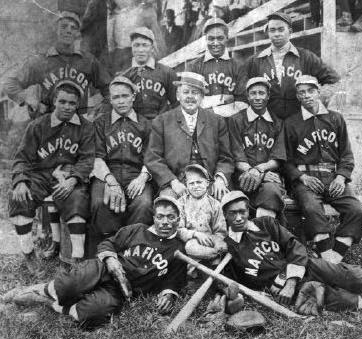Rosters 1920 Dayton Marcos (1920): Alexander (lf), Slim Branham (p), George (Chippy) Britt (p, 2b,c), George Brown (of, 1b), Clarence Coleman (p, rf), Cunningham (ss), S.R. (Eddie) Dewitt (2b), Gardner (of), G.E. Dolly Gray (p), Bruce Hocker (1b, of), William (Wise) Johnson (c,rf), I.S. Lane (p, rf), Leary (p), Edward (Boots) McClain (ss), McNeil (1b, c), Mitch Murray (c), Hurland Ragland (p), Curtiss Ricks (1b), Rudledge (p), Shelton (c), Candy Jim Taylor (3b, 2b), Thompkins (of), James (Sandy) Thompson (rf), William (Speck) Webster (c), Charles Wilson (p), Wingfield (2b, of). 1926 Dayton Marcos: Henry Baker (1b), Don Bennett (2b), Howard Black (p), Chester Blanchard (2b, ss), George Boggs (of), Bradshaw (of), Charles Brooks (of, inf), Albert Clark (p), Troy Dandridge (ss), S.R. Eddie Dewitt (3b), Dimes (lf), Ducey (rf, lf), Bill Evans (cf), Fields (p), Joe Hewitt (2b,ss), Hinkey (of), Eddie Huff (c, rf), Eugene Keeton (p), Kirksey (c, 2b), Bill Lindsey (ss, cf), Wm. Jack Marshall (2b), Wm. Stack Martin (p, lf), Ed. Boots McClain (2b, ss), George Meyers (p, ss), Omer Nwsome (p, 1b), Wm. Owens (ss, 2b), Leon Palmer (2b), Ev. Radcliffe (ss), Curtiss Ricks (1b), E. Russell (3b), Smith (p), Taylor (1b), Harold Tredwell (p, rf), Whitlock (1b), John Williams (p, 1b), Elmer Wilson (2b). |
Research with local sources, however, does reveal some facts about the team's history. The picture shown here was apparently taken at Westwood Field - which no longer exists - on James H. McGee Boulevard (then Western Avenue). Alberta Robinson Sloan owned the photograph, and in the upper left is Bill Sloan. Although no others in the picture are identified, the man in the middle with the straw hat appears to be John Matthews, the team's owner. It would also appear the picture was taken close to 1920, the Marcos' first season in the Negro National League.
The picture shown here was apparently taken at Westwood Field - which no longer exists - on James H. McGee Boulevard (then Western Avenue). Alberta Robinson Sloan owned the photograph, and in the upper left is Bill Sloan. Although no others in the picture are identified, the man in the middle with the straw hat appears to be John Matthews, the team's owner. It would also appear the picture was taken close to 1920, the Marcos' first season in the Negro National League.